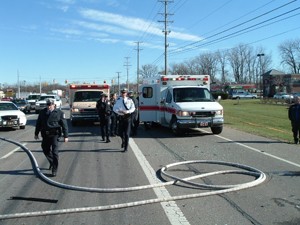
First Community Paramedicine Course Underway through UC
The University of Cincinnatis College of Engineering and Applied Science (UC CEAS) Fire Science & Emergency Management Program is hosting the first Community Paramedicine course, titled Foundations of EMS and Community Paramedicine, from Feb. 17-21, 2014, at Station 58, Deerfield Township Fire Department on Kings Mills Road in Mason, Ohio. The residency course addresses the current issue fire and emergency professionals are facing of how to properly assist frequent 911 callers, often elderly individuals.
The course features guest speakers who are both locally and nationally recognized fire and emergency professionals, including
- Bill Raynovich: Raynovich is from Creighton University in Omaha, Neb., and hell be discussing the best community paramedicine practices found across the nation.
- Deanna Harris: Harris is the chief flight nurse at Cleveland Metro Life Flight and chair of the Community Paramedicine Committee and Ohio EMFTS Board. She will describe Ohios progress in community paramedicine.
- Debi Sampsel: Sampsel (UC College of Nursing, chief officer of innovation and entrepreneurship) will explain UCs Maple Knoll Smart Home for older adults as UC continues to aid in community paramedicine efforts.
Cincinnati Fire Chief Richard Braun will lead a panel discussion on the topic Community Paramedicine: Helping City Residents alongside Tonda Francis, vice president and regional hospital coordinator, Greater Cincinnati Health Council; Jack Mix, EMS coordinator, Dayton Fire Department; and Carter Pittman (EMT-P), emergency response coordinator, Hamilton County Public Health.
Other panel discussions covering topics of Helping the Aged, FD Innovations, Hospitals and EMS Training, and Community Paramedicine and Retirement Centers are also set to take place with distinguished speakers. This course precedes UC Fire Sciences NFAs model courses in EMS Administrationwhich are the first of their kind to be offered in the nation. These courses are set to begin on May 12, 2014, for UCs 2014 Summer Semester. Courses such as EMS Quality and Performance Management, Leadership in Fire & EMS, and Legal, Political and Regulatory Environment of EMS are to be taught through innovative group teaching in which two or more instructors, who are fire and emergency professionals, lead the course to combine their field expertise for a well-rounded educational experience.
For more information, please contact Kathy Angne, program coordinator, at 513-556-6583 or
or Larry Bennett, program chair, at 513-470-2744 or
For more information UC Fire Sciences Foundations of EMS and Community Paramedicine" residency course or 2014 Summer Semester NFAs model courses in EMS Administration, please visit:
http://ceas.uc.edu/news-1314/fire-science-hosts-1st-community-paramedicine-course-.html
For more information about the Fire Science & Emergency Management Program, please visit:
http://aerospace.ceas.uc.edu/FireScience
For more information about the UC College of Engineering and Applied Science, please visit:
Related Stories
UC hires Dr. Gregory Postel as senior vice president of health...
April 23, 2024
UC Board of Trustees vote to hire Dr. Gregory Postel as senior vice president of health affairs and dean of UC College of Medicine.
UC, Nexigen agree to collaborate on AI security
April 23, 2024
An agreement between the University of Cincinnati and information technology and cybersecurity firm Nexigen will lead to collaboration on artificial intelligence, which includes a goal of making the technology more secure. Nexigen, one of the Cincinnati region's largest IT service and cybersecurity firms, builds technology solutions for companies in the United States. While not a legally binding contract, the agreement between the Kentucky-based company and UC will lead to cooperation on securing grants, give UC students real-world experience and provide Nexigen with expertise from UC faculty and students.
WVXU: Find your CPAP annoying? UC researchers are working on a...
April 22, 2024
Dr. Liran Oren is leading a research team at the University of Cincinnati developing a VortexPAP machine that takes advantage of vortex airflow technology. A preliminary clinical study with current CPAP users demonstrated that the VortexPAP can deliver the pressure levels that are used in the subjects’ CPAP therapy, but the mask is more comfortable to wear. It has a minimalistic design that is less intrusive and barely touches the patient’s face.
